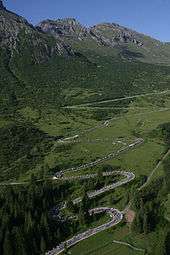The 1979 Giro d'Italia was the 62nd running of the Giro d'Italia, one of cycling's Grand Tours races. The Giro started in Genoa, on 17 May, with a 8 km (5.0 mi) prologue and concluded in Milan, on 6 June, with a 44 km (27.3 mi) individual time trial. A total of 130 riders from thirteen teams entered the 19-stage race, that was won by Italian Giuseppe Saronni of the Scic-Bottecchia team. The second and third places were taken by Italian Francesco Moser and Swede Bernt Johansson, respectively.[1][2]
In addition to the general classification, Saronni won the points classification, Amongst the other classifications that the race awarded, Claudio Bortolotto of Sanson Gelati-Luxor TV won the mountains classification, and Bianchi-Faema's Silvano Contini completed the Giro as the best rider aged 24 or under in the general classification, finishing fifth overall. Scic-Bottecchia finishing as the winners of the team classification, ranking each of the twenty teams contesting the race by lowest cumulative time.
Teams
Thirteen of the fourteen teams invited to the 1979 Giro d'Italia participated in the race.[3] Kas were forced to decline their invitation, in favor of racing the Vuelta a España, by the Spanish Federation which wanted the "best Hispanic" peloton to be competing in Vuelta that year.[4] Each team sent a squad of ten riders, which meant that the race started with a peloton of 130 cyclists.[3] From the riders that began this edition, 111 made it to the finish in Milan.[5]
The teams entering the race were:[3][6]
|
|
|
- Sapa Assicurazioni
- Scic-Bottecchia
- Willora-Piz Buin-Bonanza
- Zonca-Santini
|
Pre-race favorites
The starting peloton did include the 1978 winner, Johan De Muynck. Successful French rider Bernard Hinault did not enter the race.[7]
Route and stages
The route was unveiled on 22 March 1978.[8] Covering a total of 3,301 km (2,051 mi), it included five individual time trials, and nine stages with categorized climbs that awarded mountains classification points.[5][6] The organizers chose to include two rest days. When compared to the previous year's race, the race was 309 km (192 mi) shorter and contained one more time trial. In addition, this race contained one less stage.
Classification leadership

A sample of the road climbing to the top of the
Passo Pordoi, the
Cima Coppi (highest elevation point) of the 1979 Giro.
Three different jerseys were worn during the 1979 Giro d'Italia. The leader of the general classification – calculated by adding the stage finish times of each rider, and allowing time bonuses for the first three finishers on mass-start stages – wore a pink jersey. This classification is the most important of the race, and its winner is considered as the winner of the Giro.[9]
For the points classification, which awarded a purple (or cyclamen) jersey to its leader, cyclists were given points for finishing a stage in the top 15; additional points could also be won in intermediate sprints. The green jersey was awarded to the mountains classification leader. In this ranking, points were won by reaching the summit of a climb ahead of other cyclists. Each climb was ranked as either first, second or third category, with more points available for higher category climbs. The Cima Coppi, the race's highest point of elevation, awarded more points than the other first category climbs.[9] The Cima Coppi for this Giro was the Passo Pordoi. The first rider to cross the Pordoi Pass was Italian rider Leonardo Natale. The white jersey was worn by the leader of young rider classification, a ranking decided the same way as the general classification, but considering only riders aged 24 and younger.[10]
Although no jersey was awarded, there was also one classification for the teams, in which the stage finish times of the best three cyclists per team were added; the leading team was the one with the lowest total time.[9]
The rows in the following table correspond to the jerseys awarded after that stage was run.
Final standings
General classification
References
- Citations
- ↑ "Saronni Le Robo <<Su>> <<Giro>> A Moser" [Saronni Stole <<his>> <<Tour>> from Moser] (PDF) (in Spanish). El Mundo Deportivo. 7 June 1979. p. 23. Archived from the original on 2013-06-30. Retrieved 27 May 2012.
- ↑ http://www.archiviolastampa.it/component/option,com_lastampa/task,search/mod,libera/action,viewer/Itemid,3/page,19/articleid,1074_01_1979_0124_0019_15359004/
- 1 2 3 "Squadre, corridori, numeri di gara" [Teams, runners, race numbers] (PDF). La Stampa (in Italian). Editrice La Stampa. 17 May 1979. p. 23. Retrieved 27 May 2012.
- ↑ "<<Kas>> no estara en el <<Giro>>..." [<<Kas>> to not be in the <<Giro>>] (PDF). El Mundo Deportivo (in Spanish). El Mundo Deportivo S.A. 18 February 1979. p. 25. Archived (PDF) from the original on 1 March 2015. Retrieved 27 May 2012.
- 1 2 3 4 5 Bill and Carol McGann. "1979 Giro d'Italia". Bike Race Info. Dog Ear Publishing. Archived from the original on 27 February 2014. Retrieved 2012-08-06.
- 1 2 3 http://archiviostorico.unita.it/cgi-bin/highlightPdf.cgi?t=ebook&file=/archivio/uni_1979_05/19790514_0016.pdf
- ↑ http://hemeroteca-paginas.mundodeportivo.com/EMD01/HEM/1979/02/17/MD19790217-022.pdf
- ↑ http://archiviostorico.unita.it/cgi-bin/highlightPdf.cgi?t=ebook&file=/archivio/uni_1979_03/19790323_0012.pdf
- 1 2 3 Laura Weislo (13 May 2008). "Giro d'Italia classifications demystified". Cycling News. Future Publishing Limited. Archived from the original on 17 June 2014. Retrieved 13 July 2013.
- ↑ "Clasificaciones" [Classifications] (PDF) (in Spanish). El Mundo Deportivo. 8 June 1980. p. 25. Archived (PDF) from the original on 28 February 2015. Retrieved 27 May 2012.
- 1 2 Gian Paolo Ormezzano (7 June 1979). "Saronni vince da campione il Giro di Moser" [Saronni wins the Tour champion of Moser] (PDF). La Stampa (in Italian). Editrice La Stampa. p. 19. Retrieved 27 May 2012.
- 1 2 3 4 5 6 "Pagelle del '79" [Scoreboard of '79] (PDF). l'Unità (in Italian). PCI. 12 May 1980. p. 16. Archived (PDF) from the original on 1 April 2015. Retrieved 22 June 2012.
|
|---|
|
| By year | |
|---|
|
Classifications
("jerseys") | |
|---|
|
| Lists and topics | |
|---|
